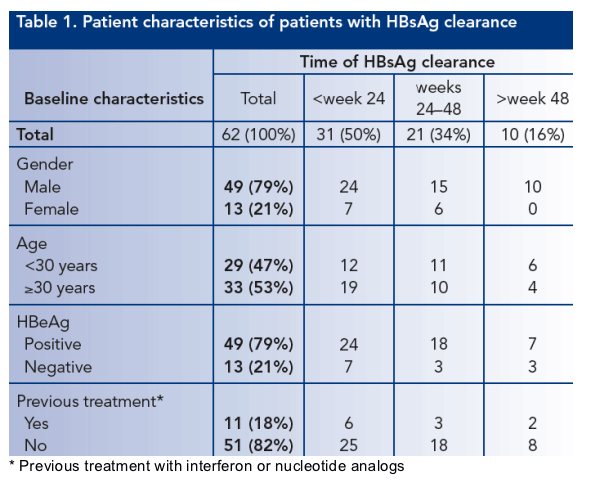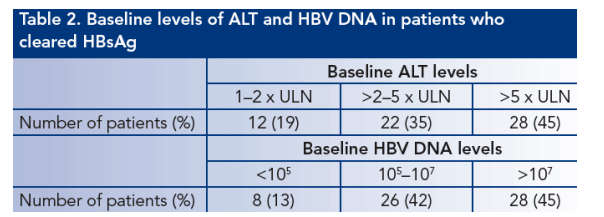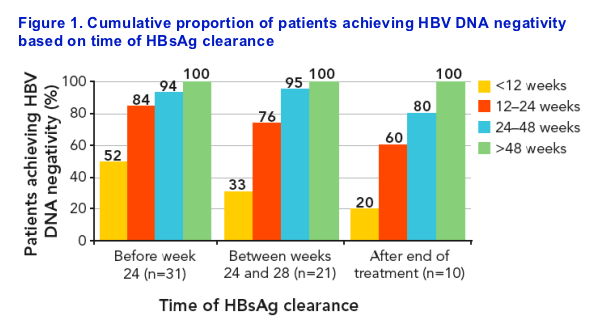 |
 |
 |
| |
Response Patterns Of Chinese Patients With Chronic Hepatitis B Who Achieved HBsAg Clearance Through Treatment With Peginterferon Alfa-2a
|
| |
| |
Reported by Jules Levin
59th Annual Meeting of the American Association for the Study of Liver Diseases, October 31-November 4 2008, San Francisco, USA
D-Z Xu,1 X-Y Chen,2 W-H Zhang3
1Infectious Disease Department, Beijing Ditan Hospital, Beijing, China; 2Infectious Disease Department, Beijing Youan Hospital, Beijing, China; 3Infectious Disease Department, Shanghai Huashan Hospital, Shanghai, China
Background
HBsAg clearance or seroconversion (loss of HBsAg and appearance of anti-HBs) can be considered the closest we can achieve to clinical cure of chronic hepatitis B infection
Favorable clinical outcomes associated with HBsAg clearance include decreased rate of cirrhosis, greatly reduced rate of liver cancer, and an increase in life expectancy1,2
HBsAg clearance, and not just the on-treatment HBV DNA suppression, can therefore be considered as the ultimate therapeutic goal of therapy in patients with chronic hepatitis B
HBsAg clearance can be achieved in patients with HBeAg-positive or HBeAg-negative disease following a finite course of interferon-based therapy, with the rates of HBsAg clearance continuing to increase in responders long after treatment has stopped.3,4,5 This is thought to be due to the ability of interferon, with its dual antiviral and immunomodulatory properties, to induce an immune response that is sustained
Rates of HBsAg clearance following treatment with peginteferon alfa-2a also increase during long-term follow up.6 Further investigation is required to determine which patients are most likely to benefit, by achieving clinical cure, from this therapeutic approach
OBJECTIVE
We aimed to investigate, through retrospective analysis, the clinical characteristics and response patterns of Chinese patients with chronic hepatitis B who achieved HBsAg clearance during or following treatment with peginterferon alfa-2a (40KD)
AUTHOR SUMMARY
This retrospective analysis provides insight into the patients who achieve HBsAg clearance following treatment with peginterferon alfa-2a
Most patients had baseline ALT levels more than twice the ULN and had more than 105 copies/mL of HBV DNA
HBV DNA levels were reduced to undetectable levels more rapidly in patients with early HBsAg clearance than in those who cleared HBsAg during the latter half of peginterferon alfa-2a treatment or after the end of therapy
High ALT levels (more than five times the ULN) were seen in the majority of patients who achieved early clearance of HBsAg
AUTHOR CONCLUSION
Clearance of HBsAg can be achieved following a finite course of peginterferon alfa-2a therapy. This analysis provides an insight into clinical characteristics and the response patterns of Chinese patients who achieved sustained immunological control of chronic hepatitis B following 48 weeks of treatment with peginterferon alfa-2a, as evidenced by HBsAg clearance. It indicates that early HBsAg clearance is closely associated with high baseline ALT levels and rapid suppression of HBV DNA during the initial 12 weeks of therapy
METHODS
Patients with chronic hepatitis B who had achieved HBsAg clearance during or following a 48-week course of treatment with peginterferon alfa-2a were identified in clinical centers across China
Demographic information from these patients was retrospectively analyzed
Responders were divided into subgroups depending on the time of HBsAg clearance:
-- during the first 24 weeks of treatment
-- between treatment weeks 24 and 48
-- after the end of treatment
RESULTS
General demographics
Hepatologists from 49 clinical centers across China provided information on 62 patients with chronic hepatitis B who had been treated with peginterferon alfa-2a for 48 weeks and achieved HBsAg clearance
The characteristics of the 62 patients are shown in Table 1
The majority of patients were male (79%), had HBeAg-positive chronic hepatitis B prior to therapy (79%) and had not received previous treatment with interferon or nucleotide analogs (82%)
31 patients (50%) achieved an early HBsAg clearance before week 24, 21 patients (34%) achieved clearance between weeks 24 and 48, and 10 patients (16%) cleared HBsAg after the end of treatment

Alanine aminotransferase (ALT) and HBV DNA levels at baseline
Baseline levels of ALT and HBV DNA are shown in Table 2
The majority of patients (81%) had baseline levels of ALT more than twice the normal upper limit of normal (ULN; 30 IU/mL)
Most patients (87%) had baseline HBV DNA levels greater than 105 copies/mL at baseline, with 45% of patients having levels greater than 107 copies/mL

Association between baseline ALT and time of HBsAg clearance
The time of HBsAg clearance was highly associated with the baseline ALT level
Baseline ALT levels more than five times the ULN were found in 58% of patients who cleared HBsAg during the first 24 weeks of treatment, in 38% of those who cleared HBsAg during treatment weeks 24-28 and in 20% of those who cleared HBsAg after completing treatment

Association between time of HBV DNA suppression and time of HBsAg
Clearance
Time of HBsAg clearance was closely related to the time to suppression of HBV DNA to undetectable levels (<1000 copies/mL); early clearance of HBsAg was associated with rapid suppression of HBV DNA
Of the 31 patients who cleared HBsAg before week 24, the majority (52%) had HBV DNA suppressed to undetectable levels (<1000 copies/mL) in the early phase of treatment, before week 12
For patients who cleared HBsAg between weeks 24-48 (n=21) or after the end of treatment (n=10), most (67% and 80%, respectively) achieved HBV DNA negativity after the first 12 weeks of treatment
Figure 1 shows the cumulative proportion of patients achieving HBV negativity based on time of HBsAg clearance
Figure 1. Cumulative proportion of patients achieving HBV DNA negativity
based on time of HBsAg clearance
REFERENCES
1. Fattovich G et al. Long-term outcome of hepatitis B e antigen-positive patients with compensated cirrhosis treated with interferon alfa. European Concerted Action on Viral Hepatitis (EUROHEP). Hepatology 1997;26(5):1338-42
2. Fattovich G et al. Delayed clearance of serum HBsAg in compensated cirrhosis B: relation to interferon alpha therapy and disease prognosis. European Concerted Action on Viral Hepatitis (EUROHEP). Am J Gastroenterol
1998;93:896-900
3. van Zonneveld M et al. Long-term follow-up of alpha-interferon treatment of patients with chronic hepatitis B. Hepatology 2004;39(3):804-10
4. Lampertico P et al. Long-term suppression of hepatitis B e antigen-negative
chronic hepatitis B by 24-month interferon therapy. Hepatology 2003;37:756-63
5. Korevaar A et al. High rates of HBsAg seroconversion in chronic hepatitis
B patients responding to interferon therapy: a long term follow-up study. Hepatology 2007;46(4):638A
6. Marcellin P et al. Virological and biochemical response in patients with
HBeAg-negative chronic hepatitis B treated with peginterferon alfa-2a (40KD) with or without lamivudine: results of 4-year follow-up. J Hepatol 2008;48 (Suppl 2):S46 (Abstract 103)
DISCLOSURE INFORMATION
Editorial support for the development of this poster was funded by F. Hoffmann-La Roche Ltd, Basel, Switzerland
|
| |
|
 |
 |
|
|